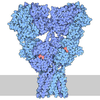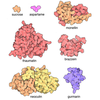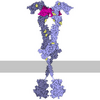+ Open data
Open data
- Basic information
Basic information
| Entry | Database: PDB / ID: 5fxk | ||||||
|---|---|---|---|---|---|---|---|
| Title | GluN1b-GluN2B NMDA receptor structure-Class Y | ||||||
 Components Components |
| ||||||
 Keywords Keywords | TRANSPORT PROTEIN / SIGNALING PROTEIN / NMDA RECEPTOR / GLUTAMATE RECEPTOR / GLUN1 / GLUN2B / ION CHANNEL | ||||||
| Function / homology |  Function and homology information Function and homology informationcellular response to curcumin / cellular response to corticosterone stimulus / cellular response to magnesium starvation / sensory organ development / pons maturation / positive regulation of Schwann cell migration / regulation of cell communication / sensitization / EPHB-mediated forward signaling / Assembly and cell surface presentation of NMDA receptors ...cellular response to curcumin / cellular response to corticosterone stimulus / cellular response to magnesium starvation / sensory organ development / pons maturation / positive regulation of Schwann cell migration / regulation of cell communication / sensitization / EPHB-mediated forward signaling / Assembly and cell surface presentation of NMDA receptors / response to hydrogen sulfide / auditory behavior / olfactory learning / conditioned taste aversion / dendritic branch / regulation of respiratory gaseous exchange / response to other organism / protein localization to postsynaptic membrane / regulation of ARF protein signal transduction / fear response / apical dendrite / transmitter-gated monoatomic ion channel activity / positive regulation of inhibitory postsynaptic potential / suckling behavior / response to methylmercury / response to manganese ion / response to glycine / propylene metabolic process / response to carbohydrate / interleukin-1 receptor binding / cellular response to dsRNA / response to growth hormone / cellular response to lipid / negative regulation of dendritic spine maintenance / heterocyclic compound binding / positive regulation of glutamate secretion / regulation of monoatomic cation transmembrane transport / RAF/MAP kinase cascade / NMDA glutamate receptor activity / Synaptic adhesion-like molecules / voltage-gated monoatomic cation channel activity / response to glycoside / NMDA selective glutamate receptor complex / glutamate binding / ligand-gated sodium channel activity / neurotransmitter receptor complex / response to morphine / regulation of axonogenesis / neuromuscular process / calcium ion transmembrane import into cytosol / regulation of dendrite morphogenesis / protein heterotetramerization / male mating behavior / regulation of synapse assembly / glycine binding / response to amine / regulation of cAMP/PKA signal transduction / small molecule binding / parallel fiber to Purkinje cell synapse / receptor clustering / startle response / positive regulation of reactive oxygen species biosynthetic process / monoatomic cation transmembrane transport / behavioral response to pain / regulation of MAPK cascade / positive regulation of calcium ion transport into cytosol / regulation of postsynaptic membrane potential / response to magnesium ion / cellular response to glycine / associative learning / action potential / extracellularly glutamate-gated ion channel activity / excitatory synapse / response to electrical stimulus / positive regulation of dendritic spine maintenance / monoatomic cation transport / social behavior / regulation of neuronal synaptic plasticity / glutamate receptor binding / monoatomic ion channel complex / Unblocking of NMDA receptors, glutamate binding and activation / positive regulation of excitatory postsynaptic potential / long-term memory / detection of mechanical stimulus involved in sensory perception of pain / response to mechanical stimulus / synaptic cleft / neuron development / behavioral fear response / prepulse inhibition / phosphatase binding / multicellular organismal response to stress / positive regulation of synaptic transmission, glutamatergic / postsynaptic density, intracellular component / monoatomic cation channel activity / calcium ion homeostasis / response to fungicide / glutamate-gated receptor activity / cell adhesion molecule binding / regulation of neuron apoptotic process / regulation of long-term synaptic depression Similarity search - Function | ||||||
| Biological species |  | ||||||
| Method | ELECTRON MICROSCOPY / single particle reconstruction / cryo EM / Resolution: 6.4 Å | ||||||
 Authors Authors | Tajima, N. / Karakas, E. / Grant, T. / Simorowski, N. / Diaz-Avalos, R. / Grigorieff, N. / Furukawa, H. | ||||||
 Citation Citation |  Journal: Nature / Year: 2016 Journal: Nature / Year: 2016Title: Activation of NMDA receptors and the mechanism of inhibition by ifenprodil. Authors: Nami Tajima / Erkan Karakas / Timothy Grant / Noriko Simorowski / Ruben Diaz-Avalos / Nikolaus Grigorieff / Hiro Furukawa /  Abstract: The physiology of N-methyl-d-aspartate (NMDA) receptors is fundamental to brain development and function. NMDA receptors are ionotropic glutamate receptors that function as heterotetramers composed ...The physiology of N-methyl-d-aspartate (NMDA) receptors is fundamental to brain development and function. NMDA receptors are ionotropic glutamate receptors that function as heterotetramers composed mainly of GluN1 and GluN2 subunits. Activation of NMDA receptors requires binding of neurotransmitter agonists to a ligand-binding domain (LBD) and structural rearrangement of an amino-terminal domain (ATD). Recent crystal structures of GluN1-GluN2B NMDA receptors bound to agonists and an allosteric inhibitor, ifenprodil, represent the allosterically inhibited state. However, how the ATD and LBD move to activate the NMDA receptor ion channel remains unclear. Here we applied X-ray crystallography, single-particle electron cryomicroscopy and electrophysiology to rat NMDA receptors to show that, in the absence of ifenprodil, the bi-lobed structure of GluN2 ATD adopts an open conformation accompanied by rearrangement of the GluN1-GluN2 ATD heterodimeric interface, altering subunit orientation in the ATD and LBD and forming an active receptor conformation that gates the ion channel. | ||||||
| History |
|
- Structure visualization
Structure visualization
| Movie |
 Movie viewer Movie viewer |
|---|---|
| Structure viewer | Molecule:  Molmil Molmil Jmol/JSmol Jmol/JSmol |
- Downloads & links
Downloads & links
- Download
Download
| PDBx/mmCIF format |  5fxk.cif.gz 5fxk.cif.gz | 432.1 KB | Display |  PDBx/mmCIF format PDBx/mmCIF format |
|---|---|---|---|---|
| PDB format |  pdb5fxk.ent.gz pdb5fxk.ent.gz | 279.5 KB | Display |  PDB format PDB format |
| PDBx/mmJSON format |  5fxk.json.gz 5fxk.json.gz | Tree view |  PDBx/mmJSON format PDBx/mmJSON format | |
| Others |  Other downloads Other downloads |
-Validation report
| Summary document |  5fxk_validation.pdf.gz 5fxk_validation.pdf.gz | 768 KB | Display |  wwPDB validaton report wwPDB validaton report |
|---|---|---|---|---|
| Full document |  5fxk_full_validation.pdf.gz 5fxk_full_validation.pdf.gz | 801.8 KB | Display | |
| Data in XML |  5fxk_validation.xml.gz 5fxk_validation.xml.gz | 69.5 KB | Display | |
| Data in CIF |  5fxk_validation.cif.gz 5fxk_validation.cif.gz | 112.2 KB | Display | |
| Arichive directory |  https://data.pdbj.org/pub/pdb/validation_reports/fx/5fxk https://data.pdbj.org/pub/pdb/validation_reports/fx/5fxk ftp://data.pdbj.org/pub/pdb/validation_reports/fx/5fxk ftp://data.pdbj.org/pub/pdb/validation_reports/fx/5fxk | HTTPS FTP |
-Related structure data
| Related structure data |  3356MC  3352C  3353C  3354C  3355C 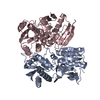 5b3jC  5fxgC  5fxhC  5fxiC  5fxjC C: citing same article ( M: map data used to model this data |
|---|---|
| Similar structure data |
- Links
Links
- Assembly
Assembly
| Deposited unit | 
|
|---|---|
| 1 |
|
- Components
Components
| #1: Protein | Mass: 95220.727 Da / Num. of mol.: 2 / Fragment: UNP RESIDUES 23-868 / Mutation: YES Source method: isolated from a genetically manipulated source Source: (gene. exp.)   #2: Protein | Mass: 92931.078 Da / Num. of mol.: 2 / Fragment: UNP RESIDUES 27-852 / Mutation: YES Source method: isolated from a genetically manipulated source Source: (gene. exp.)   |
|---|
-Experimental details
-Experiment
| Experiment | Method: ELECTRON MICROSCOPY |
|---|---|
| EM experiment | Aggregation state: PARTICLE / 3D reconstruction method: single particle reconstruction |
- Sample preparation
Sample preparation
| Component | Name: NMDA RECEPTOR / Type: COMPLEX |
|---|---|
| Buffer solution | Name: 200 MM NACL, 20 MM HEPES PH 7.0, 10 MM GLYCINE, 10 MM L-GLUTAMATE, 0.002 % MNG-3 pH: 7 Details: 200 MM NACL, 20 MM HEPES PH 7.0, 10 MM GLYCINE, 10 MM L-GLUTAMATE, 0.002 % MNG-3 |
| Specimen | Conc.: 2 mg/ml / Embedding applied: NO / Shadowing applied: NO / Staining applied: NO / Vitrification applied: YES |
| Specimen support | Details: HOLEY CARBON |
| Vitrification | Instrument: FEI VITROBOT MARK II / Cryogen name: ETHANE / Details: ETHANE |
- Electron microscopy imaging
Electron microscopy imaging
| Experimental equipment |  Model: Titan Krios / Image courtesy: FEI Company |
|---|---|
| Microscopy | Model: FEI TITAN KRIOS / Date: Aug 10, 2015 |
| Electron gun | Electron source:  FIELD EMISSION GUN / Accelerating voltage: 300 kV / Illumination mode: FLOOD BEAM FIELD EMISSION GUN / Accelerating voltage: 300 kV / Illumination mode: FLOOD BEAM |
| Electron lens | Mode: BRIGHT FIELD / Nominal magnification: 22500 X / Nominal defocus max: 2500 nm / Nominal defocus min: 1000 nm |
| Image recording | Electron dose: 100 e/Å2 / Film or detector model: GATAN K2 SUMMIT (4k x 4k) |
- Processing
Processing
| EM software |
| ||||||||||||||||||||
|---|---|---|---|---|---|---|---|---|---|---|---|---|---|---|---|---|---|---|---|---|---|
| Symmetry | Point symmetry: C2 (2 fold cyclic) | ||||||||||||||||||||
| 3D reconstruction | Resolution: 6.4 Å / Num. of particles: 15000 Details: SIDE CHAINS WERE NOT INCLUDED IN THE MODEL SUBMISSION BASED ON EXPERIMENTAL DATA FROM EMDB EMD-3356. (DEPOSITION ID: 14328). Symmetry type: POINT | ||||||||||||||||||||
| Atomic model building | Protocol: OTHER / Space: REAL / Target criteria: REAL SPACE / Details: METHOD--REAL SPACE | ||||||||||||||||||||
| Refinement | Highest resolution: 6.4 Å | ||||||||||||||||||||
| Refinement step | Cycle: LAST / Highest resolution: 6.4 Å
|
 Movie
Movie Controller
Controller



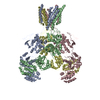






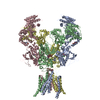
 PDBj
PDBj